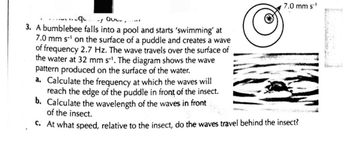Question
answers are given as
(a)3.5hz
(b)9.3 mm
(c)39mm/s

Transcribed Image Text:....q -y aue...t
3. A bumblebee falls into a pool and starts 'swimming' at
7.0 mm s-¹ on the surface of a puddle and creates a wave
of frequency 2.7 Hz. The wave travels over the surface of
the water at 32 mm s-¹. The diagram shows the wave
pattern produced on the surface of the water.
7.0 mm s-¹
a. Calculate the frequency at which the waves will
reach the edge of the puddle in front of the insect.
b. Calculate the wavelength of the waves in front
of the insect.
C. At what speed, relative to the insect, do the waves travel behind the insect?
Expert Solution
This question has been solved!
Explore an expertly crafted, step-by-step solution for a thorough understanding of key concepts.
Step by stepSolved in 5 steps with 17 images

Knowledge Booster
Similar questions
- There are 2.54 cm per inch. 3.1 cm is the same distance asarrow_forwardThe radius of a sphere is known to be r = 6.27 ± 0.06 cm. The volume of a sphere is given by (4/3)?r3. Find the absolute uncertainty and the percent uncertainty in the volume of the sphere. absolute uncertainty cm3 percent uncertaintyarrow_forwardWhich of the following calculations have the correct number of significant figures in the final result? 2.2 ст + 2.00 ст — 4.20 ст O 12.34 g 3.94 cm³ 3.132 cm3 V 2.0 cm - 1 cm = 1 cm V 11.32 cm x 6.31 cm x 6.762 cm = 4.83 × 10² cm³ V 10.32 cm × 6.31 cm × 6.762 cm = 4.40 × 10² cm³ V 1.0 x 10'g 0.27 cm 37 cmarrow_forward
- It's showing that b is not correct. Thank you for your help with this practice problem.arrow_forwardThe measurement of a physical quantity is 4.76 m with 1.47% uncertainty. Therefore, the measurement is likely to be between: * 4.63 m and 4.78 m. O 4.67 m and 4.80 m. 4.69 m and 4.83 m. 4.71 m and 4.85 m. 4.73 m and 4.88 m.arrow_forwardGiven that sin u = 1> V5 and cos u = -2>V5, use trigonometric identities to find the values of tan u, cot u, sec u, and cse u.arrow_forward
- A stone is tossed into the air from ground level with an initial velocity of 30 m/s. Its height at time t is h(t) : 30t – 4.9t2 m. Compute the stone's average velocity ū in m/s over the time intervals [2, 2.01], [2,2.001], [2,2.0001] and [1.9999, 2], [1.999, 2], [1.99, 2]. (Use decimal notation. Give your answers to three decimal places.) Ū12,2.01] = m/s Ü12,2.001] = m/s U12,2.0001] = m/sarrow_forwardPLEASE ANSWER QUICKLYarrow_forwardA partly-full paint can has 0.515 U.S. gallons of paint left in it. (a) What is the volume of the paint, in cubic meters? (b) If all the remaining paint is used to coat a wall evenly (wall area = 12.1 m²), how thick is the layer of wet paint? Give your answer in meters. (a) Number i 1.949 (b) Number i 312.1 Units m^3 v Units m^2arrow_forward
- 1.4 Units in equations Given that the following equation calculates position in meters (x) as a function of time in seconds (t): use dimensional analysis to determine the units of the coefficient "u". Xp = Xi + v¡t +,a,t? + 1 2.3/it3+ 2t4/3 2-3 4 2 3.4.54it + 3.7321 · w t3/2 Units of "u" arearrow_forwardboth plsarrow_forwardIn the laboratory, a measurement for (x + &) was taken as (+ &) = (33.7+0.5)S. Find the value for its reciprocal 1 1 士 (x + &x) Select one: 1 O a (0.030 ± 0.000) 1 O b. (0.0297±0.000) 1 Oc (0.030 +0.0004) o d. (0.0297±0.0004) The mass of an object was measured eight times on a balance readable to +1 a and the followng values were recorded: (298.arrow_forward
arrow_back_ios
SEE MORE QUESTIONS
arrow_forward_ios